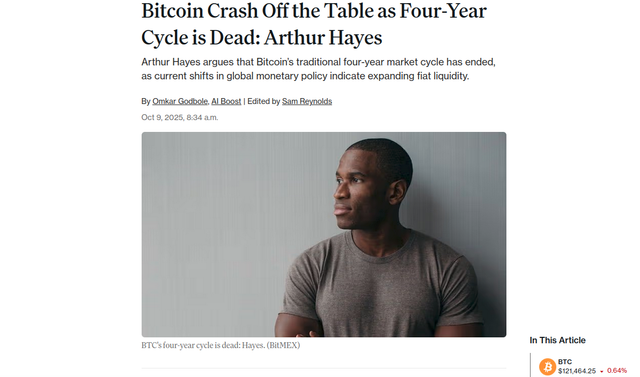Is the Four-Year Bitcoin Cycle Finally Dead?
For over a decade, Bitcoin traders have relied on a familiar rhythm — a four-year cycle anchored around the halving of mining rewards. Each time, the story seemed to repeat: a powerful bull run into and after the halving, followed by a brutal bear market about a year later.
But according to Arthur Hayes, co-founder of BitMEX and CIO of Maelstrom, that pattern no longer holds true. In his recent essay “Long Live the King!”, Hayes argues that the traditional four-year Bitcoin cycle is dead — and that the real driver of Bitcoin’s behavior is global liquidity, not the halving schedule itself.
🧠 Hayes’ Key Argument: It’s Not About the Halving Anymore
Hayes points out that previous Bitcoin crashes — in 2014, 2018, and 2022 — weren’t caused by halvings, but by tightening monetary policies around the world. Whenever central banks turned off the liquidity taps, Bitcoin tumbled by 70–80%.
Now, however, the environment is completely different. Major economies are easing, not tightening. The U.S. Federal Reserve recently cut rates to around 4% and may slash them by another 100 basis points over the coming year. Meanwhile, Japan’s new government is leaning back toward Abenomics-style stimulus, and China’s policies suggest it will avoid draining liquidity despite slower growth.
The result? A global setup that Hayes believes will keep Bitcoin rising, not crashing.
💸 The Macro Liquidity Thesis
Hayes argues that what really matters for Bitcoin’s direction is fiat liquidity — how much cheap money is circulating in the global financial system.
“Listen to our monetary masters in Washington and Beijing,” Hayes wrote.
“They clearly state that money shall be cheaper and more plentiful. Therefore, Bitcoin continues to rise in anticipation of this highly probable future.”
If fiat liquidity expands, speculative assets like Bitcoin tend to surge. If it contracts, they bleed. It’s that simple — and according to Hayes, the coming year looks like an expansion phase, not a contraction.
🔁 The End of Predictable Cycles
The fourth halving in April 2024 was supposed to set the stage for another classic pattern — euphoria, peak, and crash by 2026. But Hayes believes this time is different.
With governments running large deficits and central banks moving to make money cheaper again, Bitcoin might no longer follow its historical rhythm.
Instead of another “four-year rinse and repeat,” we could be entering a liquidity-driven supercycle, where macro policy — not block rewards — dictates the next wave of price action.
🪙 The Takeaway
- The four-year halving cycle may have lost its predictive power.
- Global monetary easing is now the dominant force behind crypto markets.
- No imminent bear market if liquidity keeps flowing.
If Hayes is right, Bitcoin’s next moves won’t depend on block timings — but on central banks’ willingness to keep printing.
Read the full analysis on CoinDesk:
👉 Bitcoin Crash Off the Table as Four-Year Cycle is Dead: Arthur Hayes

Upvoted! Thank you for supporting witness @jswit.
Wow, @thevpnboss, this is a truly insightful piece! The breakdown of Arthur Hayes' argument about the death of the four-year Bitcoin cycle is incredibly compelling. I especially appreciate how you've clearly articulated the shift in focus from halving events to the impact of global liquidity.
The image and the concise bullet points at the end really drive home the key takeaways. It's fascinating to consider that central bank policies could be the primary driver of Bitcoin's future performance, potentially ushering in a liquidity-driven supercycle.
This post has definitely got me thinking differently about the market. I'm curious to know, what are everyone's thoughts on Hayes' thesis? Do you agree that the traditional cycle is over, or do you think the halving will still play a significant role? Let's discuss!